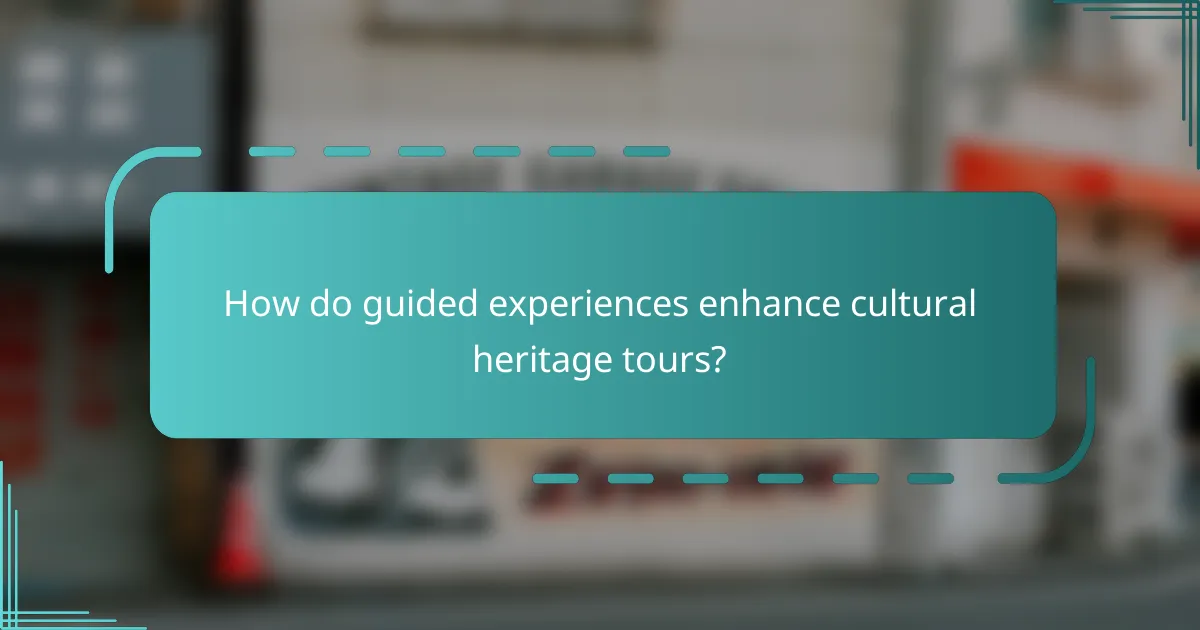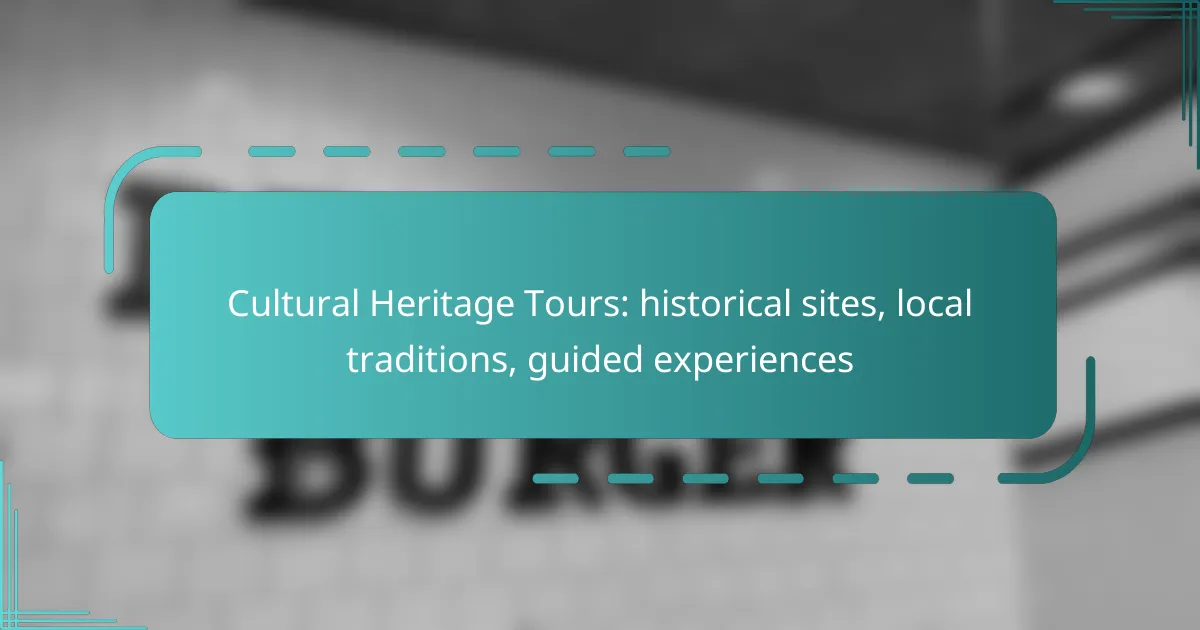Cultural heritage tours provide a unique opportunity to explore historical sites and immerse yourself in local traditions. These guided experiences not only highlight significant landmarks but also encourage meaningful interactions with the culture, allowing for a deeper understanding of the region’s rich history. By choosing a tour that aligns with your interests, you can enjoy an enriching journey that supports local communities and fosters cultural appreciation.

What are the best cultural heritage tours in Europe?
The best cultural heritage tours in Europe highlight historical sites, local traditions, and immersive experiences. These tours often include guided visits to significant landmarks, opportunities to engage with local customs, and hands-on activities that reflect the region’s rich history.
Guided tours of Rome’s historical sites
Guided tours of Rome offer a deep dive into the city’s ancient history, showcasing landmarks like the Colosseum, the Roman Forum, and the Vatican. These tours typically last a few hours to a full day and may include skip-the-line access to popular attractions.
When choosing a guided tour, consider the group size and the expertise of the guide. Smaller groups often provide a more personalized experience, while knowledgeable guides can enrich your understanding of the historical context.
Local traditions in Greece
Exploring local traditions in Greece can be a captivating experience, with opportunities to participate in traditional dances, cooking classes, and local festivals. Tours often focus on specific regions, such as Crete or the Peloponnese, where you can engage with local artisans and farmers.
To make the most of these cultural experiences, look for tours that include hands-on activities, such as olive oil tasting or pottery workshops. This not only supports local communities but also provides a memorable way to connect with Greek heritage.
Experiential tours in Paris
Experiential tours in Paris allow visitors to immerse themselves in the city’s artistic and culinary heritage. Options include guided visits to art studios, wine tasting sessions, and cooking classes that focus on classic French cuisine.
When selecting an experiential tour, consider your interests and the duration of the activity. Many tours are designed to fit within a few hours, making them easy to incorporate into a busy travel itinerary. Look for reviews to ensure the quality of the experience and the expertise of the hosts.

How to choose the right cultural heritage tour?
Choosing the right cultural heritage tour involves understanding your interests and assessing the tour’s structure. Focus on what aspects of culture resonate with you, and ensure the itinerary aligns with your preferences for an enriching experience.
Consider your interests and preferences
Your interests play a crucial role in selecting a cultural heritage tour. Think about whether you are more drawn to historical sites, local traditions, or immersive experiences with local communities. This will help narrow down options that truly resonate with you.
For example, if you have a passion for art, look for tours that include visits to museums and galleries, while those interested in culinary traditions might prefer tours that feature local cooking classes or food markets. Tailoring your choice to your interests enhances the overall experience.
Evaluate tour duration and itinerary
The duration of the tour and its itinerary are essential factors to consider. Tours can range from a few hours to several days, so think about how much time you can dedicate. A longer tour may offer a deeper understanding of the culture, while a shorter one might provide a quick overview.
Review the itinerary carefully to ensure it includes the sites and experiences you wish to explore. Look for a balance between guided activities and free time, allowing for personal exploration. It’s also wise to check for any additional costs that may arise during the tour, such as entrance fees or optional activities.

What are the benefits of cultural heritage tours?
Cultural heritage tours offer numerous benefits, including enriching educational experiences and fostering economic growth in local communities. These tours allow participants to engage deeply with historical sites and local traditions, enhancing their understanding of different cultures.
Immersive learning experiences
Immersive learning experiences are a hallmark of cultural heritage tours, as they provide firsthand exposure to historical sites and local customs. Participants can explore ancient ruins, visit museums, and engage with local artisans, gaining insights that textbooks cannot offer.
For example, a tour in Greece might include guided visits to archaeological sites like the Acropolis, where guides share stories that bring history to life. Such experiences often include interactive elements, such as traditional cooking classes or craft workshops, which deepen understanding and appreciation of the culture.
Support for local economies
Cultural heritage tours significantly support local economies by generating income through tourism. When travelers participate in these tours, they spend money on accommodations, food, and local crafts, directly benefiting the community.
In many regions, this influx of tourism revenue can lead to job creation and the preservation of cultural sites. For instance, in countries like Italy, local guides and small businesses thrive on the patronage of tourists, ensuring that traditions and crafts are maintained for future generations.

What are popular local traditions to experience?
Experiencing local traditions provides a deep connection to a region’s culture and history. Engaging in festivals, culinary practices, and unique customs allows travelers to appreciate the richness of a destination.
Festivals in Spain
Spain is renowned for its vibrant festivals that showcase local culture and traditions. Events like La Tomatina in Buñol, where participants throw tomatoes at each other, and the Running of the Bulls in Pamplona attract visitors from around the world.
Each region has its own unique celebrations, often tied to historical events or religious observances. For example, Semana Santa (Holy Week) features elaborate processions in Seville, highlighting the country’s deep-rooted Catholic traditions.
Culinary traditions in Italy
Italy’s culinary traditions are a vital part of its cultural heritage, emphasizing regional ingredients and time-honored recipes. Each area boasts its own specialties, such as pasta in Emilia-Romagna and seafood in Sicily, reflecting local agricultural practices and historical influences.
Participating in a cooking class can provide hands-on experience with these culinary traditions. Visitors can learn to make authentic dishes like risotto or pizza, gaining insight into the importance of family recipes and communal dining in Italian culture.

How do guided experiences enhance cultural heritage tours?
Guided experiences significantly enhance cultural heritage tours by providing in-depth knowledge and context that enrich the visitor’s understanding of historical sites and local traditions. With expert guides leading the way, tourists gain access to stories and insights that are often overlooked in self-guided explorations.
Expert insights from local guides
Local guides bring a wealth of knowledge about the history, culture, and significance of the sites visited. Their expertise allows them to share anecdotes and lesser-known facts that create a deeper connection to the location. For instance, a guide in Rome might explain the historical context of the Colosseum beyond what is found in guidebooks.
Additionally, guides can answer questions in real-time, tailoring the experience to the interests of the group. This personalized interaction often leads to a more engaging and memorable tour, as visitors feel more involved in the narrative of the heritage site.
Access to hidden gems
Guided tours often include access to hidden gems that are not typically found on standard tourist itineraries. These locations can range from secluded historical landmarks to local artisan workshops, providing a unique glimpse into the culture. For example, a tour in Kyoto might take visitors to a lesser-known temple that offers a tranquil experience away from the crowds.
Moreover, guides can navigate complex local regulations and customs, ensuring that visitors respect cultural practices while exploring these hidden treasures. This not only enhances the experience but also fosters a sense of responsibility towards preserving cultural heritage.

What are the costs associated with cultural heritage tours?
The costs of cultural heritage tours can vary widely based on factors such as location, duration, and the level of service provided. Generally, travelers should expect to budget for both the tour price and additional expenses that may arise during their experience.
Average pricing for guided tours
Guided cultural heritage tours typically range from around $50 to $200 per person for a half-day to full-day experience. Prices can fluctuate based on the destination, the expertise of the guide, and the inclusivity of the package, such as meals or entrance fees to historical sites.
In popular tourist destinations, premium tours may exceed $300, especially if they offer unique experiences like private access to sites or specialized themes. Always compare options to find the best fit for your budget and interests.
Additional expenses to consider
In addition to the base tour cost, travelers should account for extra expenses such as transportation to the tour starting point, tips for guides, and any entry fees for specific sites not included in the tour package. These can add up, so it’s wise to plan accordingly.
Other potential costs include meals, souvenirs, and optional activities. For instance, if a tour offers a local cooking class or a traditional performance, these experiences may require additional fees. Always read the fine print to understand what is included and what is not.
